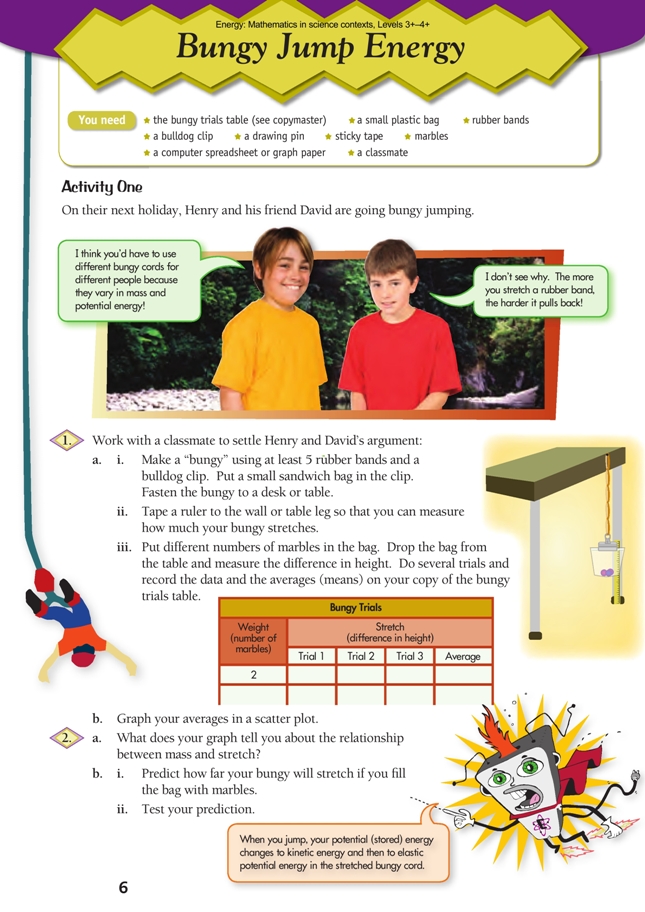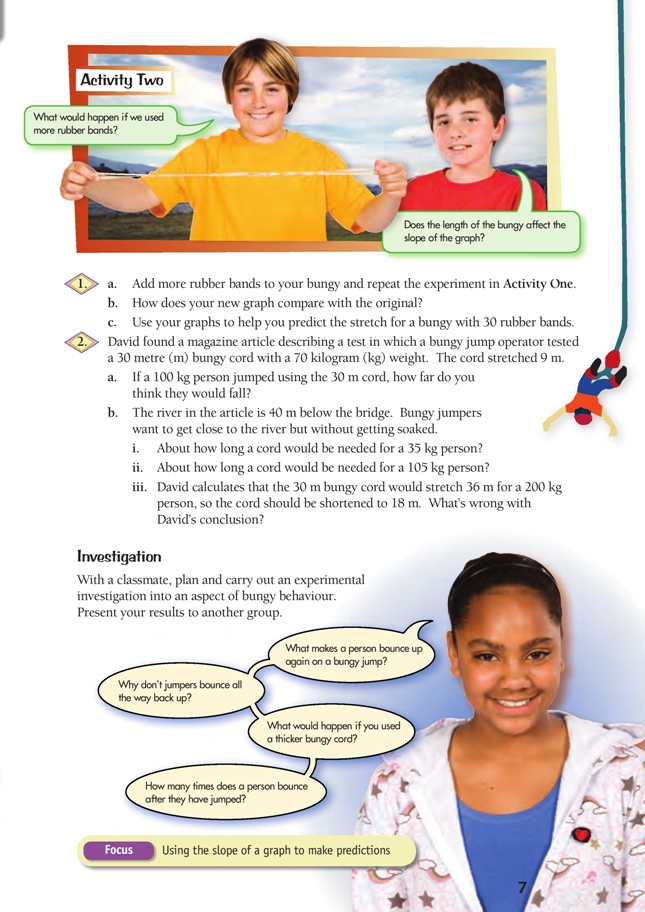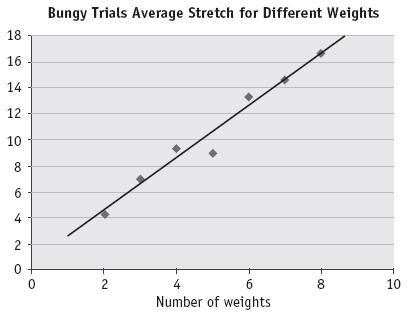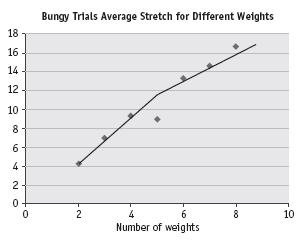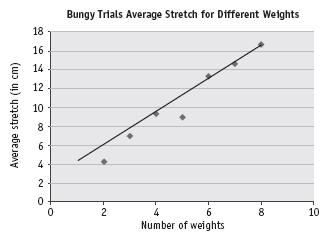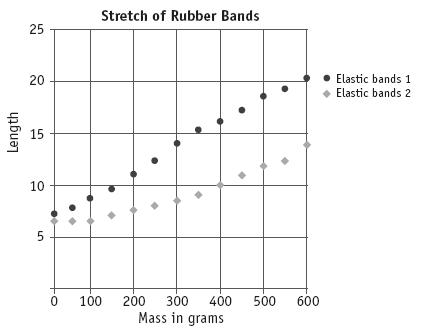This is a level (3+ to 4+) mathematics in science contexts activity from the Figure It Out series.
A PDF of the student activity is included.
Click on the image to enlarge it. Click again to close. Download PDF (1045 KB)
Students will:
- measure, record, and average data for 2 variables (number of marbles and bungy cord stretch)
- plot a scatter graph using appropriate scales (independent variable on x-axis [number of marbles]; dependent variable [overall length] on y-axis)
- use tables and graphs to identify patterns/ relationships
- use the relationship between weight and stretch to make predictions.
Students should discover that:
- the more marbles there are in the bag, the greater the stretch. (This relationship is reasonably linear.)
- averaging helps smooth out inconsistencies and reveal patterns. (Rubber bands don’t all have the same stretch, and stretch is hard to measure, so predictions are necessarily estimates.)
a bulldog clip
a drawing pin
sticky tape
marbles
a small plastic bag
the bungy trials table (see copymaster)
a computer spreadsheet or graph paper
a classmate
FIO, Energy, Levels 3+-4+, Bungy Jump Energy, pages 6 - 7
Preparation and points to note
The students need to understand that stretch is the difference in length, not the total length. In other words, they should treat the length of the unstretched bungy as 0 and focus on the increase in length as marbles are added to the bag.
Dynamic stretch is the difference between the length of the rubber band when unstretched and the length reached when the bag is first dropped. Static stretch is the difference between the unstretched length of the rubber band and its length after it has come to a complete stop. The students should try to measure the dynamic rather than the static stretch of their “bungy” because this is what matters with a real bungy. But they will have to be quick.
Use identical, thin rubber bands (rather than thick ones) so that they stretch similarly when the marble bag is added.
As with the pendulum experiment on pages 4–5, choose groups carefully and ensure that there is enough working space for each group to work comfortably.
As well as fostering thinking, the challenges in Bungy Jump Energy will build new knowledge and require the use of precise language and appropriate tools – all part of the key competency using language, symbols, and texts.
Points of entry: Mathematics
The core of this activity is the relationship between force* (the weight caused by gravity acting on the mass of marbles) and elastic energy (measured as stretch). Reinforce the meaning of dependent and independent variables and focus the students on fi nding the relationship between force and stretch. They should do this by looking at overall or average patterns and trends.
As with any statistical investigation, reinforce the elements of the statistical enquiry cycle: problem, plan, data, analysis, conclusion.
Prompt the students to think about why they are asked to average multiple trials instead of using the data from a single trial. (All measurement is subject to error. Particularly as this task involves speed and line-of-sight measuring, the likelihood of significant error is considerable. Averaging smoothes out the overs and unders and gives a more genuinely representative measurement.)
Note that the relationship between force and stretch is NOT linear (perfect data would not give a straightline graph) – it is actually quadratic (mgh = ). Nevertheless, a straight line gives a surprisingly useful approximation. Without going into detail, explain this to your students.
Introduce or reinforce the concept of rate of change and the slope of a graph as a measure of rate of change. If 5 rubber bands stretch 8 cm for 6 marbles, they will stretch about 16 cm for 12 marbles (2 cm for every 3 marbles). In Activity Two, link question 1c to David’s question: “Does the length of the bungy cord affect the slope of the graph?” on page 7. In other words, will a longer cord stretch the same amount as a shorter cord for the same weight? (Probably not – it will stretch more! A longer cord will be less stiff, so it will stretch more for each increment of weight, which means that the slope of the line will be greater [the same increase in weight will give a larger increase in stretch on a longer cord]).
When graphing their data, the students should follow protocol, putting the independent variable (weight) on the x-axis and the dependent variable (stretch) on the y-axis. Discuss the shape of the graph and why it has that shape.
Suggest that your students draw a line of best fit (trend line) to help them make predictions. This does not mean connecting the dots! The trend line should follow the direction of the trend, going through the “middle” of the data points with about half on either side, as shown in the sample graph below:
The trend line below is invalid. While it does have about the same number of points above and below the line, it isn’t straight and the distance of the points below the line from the trend is much greater than the distance of the points above the line.
The trend line below is also invalid. It is too high; most points are below the line.
Points of entry: Science
This activity is similar to the pendulum activity on pages 4–5. The force of gravity acting on a mass is
converted into elastic potential energy as it stretches the cord. Discuss the energy changes with the students; for example, the stretch is converted back into kinetic energy when the bungy rebounds.
Discuss good experimental technique with the students. For example, they should drop the bag of marbles the same way for each trial.
Encourage the students to research the force of gravity, elastic potential energy, rubber band elasticity, and Hooke’s Law.
Hooke’s Law states that, for perfect springs, force = the spring constant x distance, where the spring constant is a property of the material. The spring constant of typical rubber bands varies widely, between about 8 and 60 newtons per metre.
An experiment on Hooke’s Law can be found at: www.practicalphysics.org/go/Experiment_1024.html.
An experiment with detail on the energy transfers that take place in bungy jumping can be found at
http://stokes.byu.edu/teaching_resources/bungee.html)
Rubber bands are not perfect springs. Ask What might be the consequences of too little weight or too much weight? (With too little weight, rubber bands won’t stretch at all; with too much weight, they may deform [stretch permanently] or snap.)
Tap into your students’ prior knowledge of springs and energy. Ask, for example, Do car springs compress more when the car is full or empty? (A car suspension will “bottom out” [compress to the limit] if you try and cram too many passengers in the vehicle.)
To make the comparison between Activity One and Activity Two easier, suggest that the total number of bands used in the second activity is a multiple of the number of bands used in the first activity (that is, if you start with 3 bands in Activity One, then use either 6 or even 9 bands in Activity Two).
A sample comparison graph is shown here:
As an extension, encourage the students to experiment with a variety of types of bands, number of bands, number of twists, and what effect putting the bands side-by-side (in parallel) or end-to-end (series) has on the overall stretch.
Answers
Activity One
1. a.–b. Practical activity. Results, tables, and graphs will vary.
2. a. Your graph should show that stretch depends on weight (as weight increases, so does stretch). With weight plotted on the x-axis and stretch on the y-axis, the data points on your graph should head towards the top right-hand region.
b. i.–ii. Predictions and results will vary. You could draw a trend line on your graph to help you with your prediction.
Activity Two
1. a.–c. Practical activity. Results, comments, and predictions will vary. The new bands will make your bungy cord longer, so you should get more stretch for the same amount of weight. The length of the cord will affect the slope of your graph: a longer cord will have a steeper trend line.
Instead of adding the extra bands to the end of your bungy, you could add them in parallel (doubling the thickness). The bungy will be less stretchy than before, so the trend line of your graph will be less steep.
2. a. All you can be sure of is that the cord will stretch more than 9 m because the weight is greater.
Assuming that stretch is roughly proportional to weight, 100 kg will probably stretch the
cord to a length greater than 40 m. (100 kg is 143% of 70 kg, and 143% of 9 m is a stretch of 12.9 m, for a total of about 42.9 m.)
b. i. Approximately 35 m, if stretch is roughly proportional to weight.
The 70 kg person stretched the 30 m bungy 9 m. At half this weight, a 35 kg person should stretch the same cord about half as much (approximately 4.5 m, which represents 1.5 m of stretch for each 10 m of cord or 0.75 m of stretch for each 5 m of cord).
To just touch the river 40 m below, the cord should be about 35 m long. (The stretch would be about 4.5 [for the 30 m] + 0.75 [for the 5 m] = 5.25 m. Added to the unstretched length of 35 m, this gives a fall of 40.25 m.)
ii. Approximately 28 m, if stretch is roughly proportional to weight. 105 kg is 150% of 70 kg. The 70 kg person stretched a 30 m bungy 9 m. Assume a 105 kg person would stretch the 30 m bungy
150% x 9 = 13.5 m or 4.5 m per 10 m of cord or 45 cm per metre.
| Bungy length (105 kg weight) if length is roughly proportional to weight | ||
| Unstretched length of cord (m) | Stretch (m) | Total length when stretched (m) |
| 30 | 13.5 | 43.5 |
| 29 | 13.1 | 42.1 |
| 28 | 12.6 | 40.6 |
| 27 | 12.2 | 29.2 |
iii. David made at least two mistakes:
Given that the 30 m cord stretched 9 m for a 70 kg person, it is unlikely that it would stretch 4 times that amount (36 m) for a person who was slightly less than 3 times the weight (200 kg).
He calculated that the 30 m cord would stretch to 30 + 36 = 66 m (220%). Even if the 18 m cord were able to stretch by 220%, the total length would be 18 x 2.2 = 39.6 m, so the 200 kg person
would not reach the water.
Investigation
Investigations and presentations will vary. However, each presentation should discuss gravity, energy, and energy loss. These points could be made:
- A person bounces back up again because their gravitational potential energy is converted to kinetic energy as they fall, and this kinetic energy is stored as elastic potential energy in the bungy cord.
- At the bottom of a jump, potential energy from the person’s height at the top of the jump has been transferred to the cord. The person stops for a brief moment in mid-air. The cord is stretched, so it contains a lot of energy, but the jumper’s kinetic energy is now zero.
- All that keeps the cord from bouncing straight back is the force of the jumper’s weight. This weight is absorbed by the stretch. During their fall, the jumper has lost gravitational potential energy. This extra energy now sends them upwards as the cord unstretches.
- A bungy jumper doesn’t bounce all of the way back up because some energy is lost to friction in the cord and air resistance.
